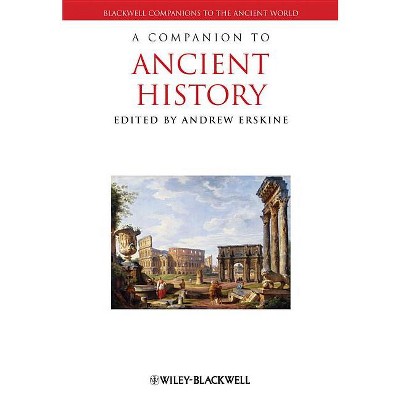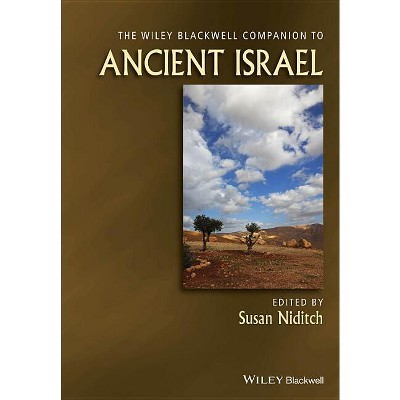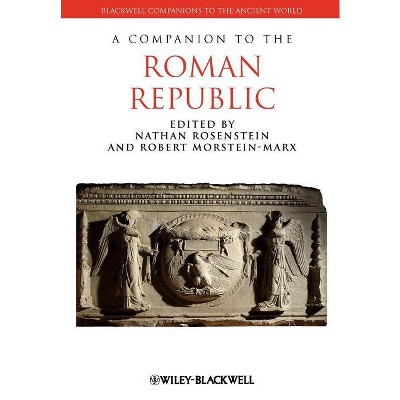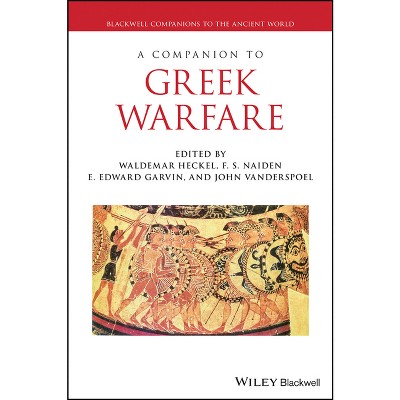A Companion to Ancient Near Eastern Languages - (Blackwell Companions to the Ancient World) by Rebecca Hasselbach-Andee

About this item
Highlights
- Covers the major languages, language families, and writing systems attested in the Ancient Near East Filled with enlightening chapters by noted experts in the field, this book introduces Ancient Near Eastern (ANE) languages and language families used during the time period of roughly 3200 BCE to the second century CE in the areas of Egypt, the Levant, eastern Anatolia, Mesopotamia, and Iran.
- About the Author: Rebecca Hasselbach-Andee, PhD, received her PhD in Semitic Philology from Harvard University in 2004.
- 560 Pages
- History, Ancient
- Series Name: Blackwell Companions to the Ancient World
Description
About the Book
"The current volume serves as an introduction to a representative sample of Ancient Near Eastern languages and language families attested during the time period of roughly 3200 BCE to the second century CE. This time-frame reflects the time from the beginning of writing (around 3200 BCE) to the end of cuneiform writing in the second century CE. The geographical scope selected reaches from Egypt through the Levant, Anatolia, northern Syria, Mesopotamia, all the way to southern Arabia and thus reflects all major cultures attested in the Ancient Near East during this time period. Although it was impossible to include a description of all languages attested in this wide geographical area throughout more than three millennia due to limitations in space, at least most language families are represented, such as Egyptian, Sumerian, Semitic, Indo-European, Elamite, and Hurrian"--Book Synopsis
Covers the major languages, language families, and writing systems attested in the Ancient Near East
Filled with enlightening chapters by noted experts in the field, this book introduces Ancient Near Eastern (ANE) languages and language families used during the time period of roughly 3200 BCE to the second century CE in the areas of Egypt, the Levant, eastern Anatolia, Mesopotamia, and Iran. In addition to providing grammatical sketches of the respective languages, the book focuses on socio-linguistic questions such as language contact, diglossia, the development of literary standard languages, and the development of diplomatic languages or "linguae francae." It also addresses the interaction of Ancient Near Eastern languages with each other and their roles within the political and cultural systems of ANE societies.
Presented in five parts, The Companion to Ancient Near Eastern Languages provides readers with in-depth chapter coverage of the writing systems of ANE, starting with their decipherment. It looks at the emergence of cuneiform writing; the development of Egyptian writing in the fourth and early third millennium BCI; and the emergence of alphabetic scripts. The book also covers many of the individual languages themselves, including Sumerian, Egyptian, Akkadian, Hittite, Pre- and Post-Exilic Hebrew, Phoenician, Ancient South Arabian, and more.
- Provides an overview of all major language families and writing systems used in the Ancient Near East during the time period from the beginning of writing (approximately 3200 BCE) to the second century CE (end of cuneiform writing)
- Addresses how the individual languages interacted with each other and how they functioned in the societies that used them
- Written by leading experts on the languages and topics
The Companion to Ancient Near Eastern Languages is an ideal book for undergraduate students and scholars interested in Ancient Near Eastern cultures and languages or certain aspects of these languages.
From the Back Cover
A COMPANION TO ANCIENT NEAR EASTERN LANGUAGES
Covers the major languages, language families, and writing systems attested in the Ancient Near East
Filled with enlightening chapters by noted experts in the field, this book introduces Ancient Near Eastern (ANE) languages and language families used during the time period of roughly 3200 BCE to the second century CE in the areas of Egypt, the Levant, eastern Anatolia, Mesopotamia, and Iran. In addition to providing grammatical sketches of the respective languages, the book focuses on socio-linguistic questions such as language contact, diglossia, and the development of literary standard languages and diplomatic languages or "linguae francae." It also addresses the interaction of ANE languages with each other and their roles within the political and cultural systems of ANE societies.
Presented in five parts, The Companion to Ancient Near Eastern Languages provides readers with in-depth chapter coverage of the writing systems of ANE, starting with their decipherment. It looks at the emergence of cuneiform writing; the development of Egyptian writing in the fourth and early third millennium BCE and the emergence of alphabetic scripts. The book also covers many of the individual languages themselves, including Sumerian, Egyptian, Akkadian, Hittite, Pre- and Post-Exilic Hebrew, Phoenician, Ancient South Arabian, and more.
- Provides an overview of all major language families and writing systems used in the Ancient Near East from the beginning of writing to the end of cuneiform writing
- Addresses how the individual languages interacted with each other and how they functioned in the societies that used them
- Written by leading experts on the languages and topics
The Companion to Ancient Near Eastern Languages is an ideal book for undergraduate students and scholars interested in Ancient Near Eastern cultures and languages or certain aspects of these languages.
Review Quotes
"To sum up, A Companion to Ancient Near Eastern Languages deserves a place on every Hebrew Bible scholar's shelf (or device) alongside other standard resources on the ancient Near Eastern world of the OT." - Bulletin for Biblical Research, Vol. 31, No. 2, 2021
About the Author
Rebecca Hasselbach-Andee, PhD, received her PhD in Semitic Philology from Harvard University in 2004. After working as a preceptor for Semitic languages at Harvard, she was hired as Professor for Comparative Semitics at the University of Chicago. Hasselbach-Andee's research interests lie in the comparative study of Semitic languages. The main methodologies she applies are those of Historical Linguistics, Typology, and Sociolinguistics. Some of her publications include Sargonic Akkadian: A Historical and Comparative Study of the Syllabic Texts and Case in Semitic: Roles, Relations, and Reconstruction.





